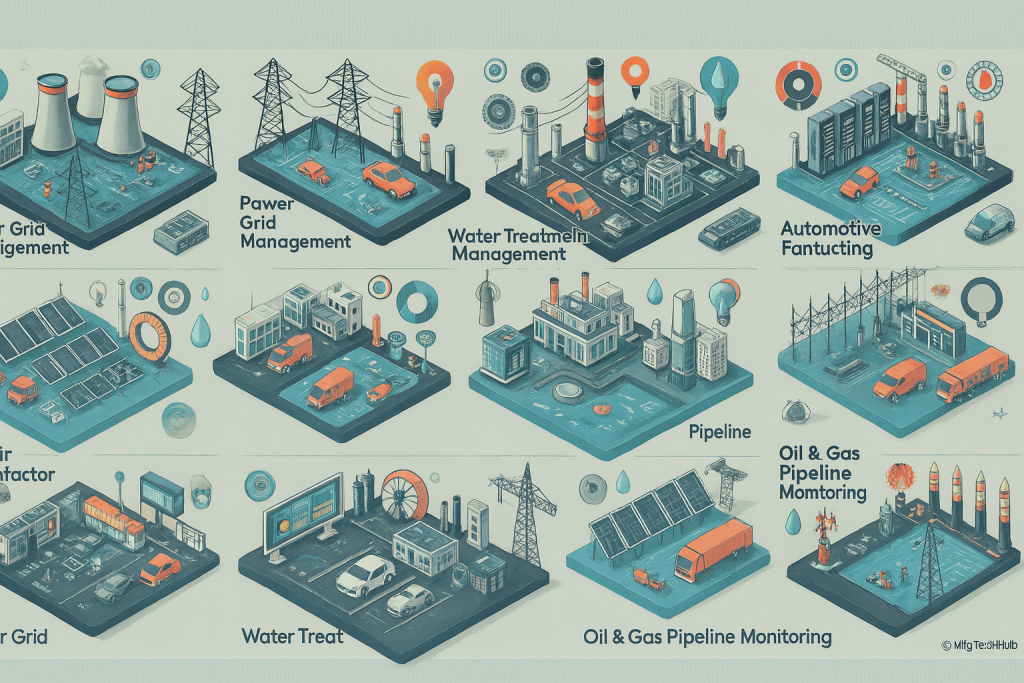SCADA Case Studies & Real-World Examples 📊🏭
SCADA (Supervisory Control and Data Acquisition) systems have become a cornerstone of modern industrial automation. From utilities and water treatment to advanced manufacturing and renewable energy, SCADA helps industries achieve real-time visibility, enhanced safety, and operational efficiency. While the concept may sound technical, the true value of SCADA is best understood through real-world applications. Below, we explore practical case studies that show how SCADA is transforming industries and driving measurable results.

1. Power Grid Management: Ensuring Stable Electricity Distribution ⚡
Scenario:
A national power utility faced frequent outages due to unstable grids and delayed fault detection. Manual monitoring meant faults often went unnoticed until major blackouts occurred. To maintain stability and prepare for renewable integration, the utility required real-time visibility and intelligent automation.
SCADA Implementation:
- ✅ Real-time monitoring of power plants, substations, and transmission lines.
- ✅ Automated fault detection and load balancing to isolate issues quickly.
- ✅ Integration with renewable energy sources for smarter distribution.
Outcomes:
- 📈 30% improvement in grid stability and reduced overload incidents.
- ⏳ 50% shorter outages thanks to immediate detection and response.
- 🌱 25% increase in renewable energy adoption, improving sustainability goals.
Lesson: For power utilities, SCADA is no longer optional—it is essential for modernizing infrastructure and ensuring energy reliability.
2. Water Treatment Facility: Reducing Water Loss & Ensuring Quality 💧
Scenario:
A municipal water authority struggled with water leakages, chemical overdosing, and inefficient treatment. Without automation, staff relied on manual inspections, leading to delays and water quality issues.
SCADA Implementation:
- ✅ Smart sensors tracked water levels, flow rates, and chemical dosing in real time.
- ✅ Automated leak detection triggered instant alerts to field teams.
- ✅ Historical trend analysis improved chemical optimization.
Outcomes:
- 🚰 20% less water loss due to rapid leak detection.
- 💰 $500,000 annual savings from optimized chemical use.
- 📊 Improved compliance with environmental regulations and public health standards.
Lesson: SCADA transforms water management into a data-driven process, saving money and ensuring clean water delivery.
3. Automotive Manufacturing: Enhancing Production Efficiency 🚗
Scenario:
A global car manufacturer wanted to optimize robotic assembly lines while reducing unplanned downtime. Traditional systems lacked predictive insights, causing frequent disruptions during production runs.
SCADA Implementation:
- ✅ Real-time dashboards tracked KPIs such as cycle times and defect rates.
- ✅ Predictive maintenance algorithms identified wear in robotics and conveyors.
- ✅ Integration with MES linked shop-floor execution with business planning.
Outcomes:
- 📦 40% rise in productivity due to reduced downtime.
- 🔧 25% fewer equipment failures from predictive insights.
- ✅ Higher quality vehicles with fewer recalls or reworks.
Lesson: In automotive, SCADA is not just about monitoring—it powers Industry 4.0 by linking robotics, MES, and analytics.
4. Oil & Gas Pipeline Monitoring: Improving Safety & Efficiency 🛢️
Scenario:
A leading oil company operated thousands of kilometers of pipelines. Manual checks were too slow, increasing risks of leaks, explosions, and environmental damage.
SCADA Implementation:
- ✅ Real-time monitoring of flow, pressure, and temperature.
- ✅ Automated valve controls for faster isolation during emergencies.
- ✅ Immediate alarm systems for leaks or abnormal pressure drops.
Outcomes:
- 🔥 Improved safety by detecting leaks instantly.
- 🌱 Reduced environmental damage through proactive responses.
- 💵 Lower costs due to efficient energy use and maintenance.
Lesson: For high-risk industries like oil & gas, SCADA is critical in protecting people, the environment, and profits.
5. Renewable Energy: Optimizing Wind Turbine Performance 🌬️
Scenario:
A wind energy operator aimed to boost turbine efficiency while reducing maintenance costs. Manual monitoring was not sustainable with dozens of turbines spread across remote locations.
SCADA Implementation:
- ✅ Real-time turbine monitoring including wind speed and blade performance.
- ✅ Automated adjustments to blade angles depending on weather.
- ✅ Benchmarking analytics compared turbines for best practices.
Outcomes:
- ⚡ 15% boost in total power output.
- 🔧 20% lower maintenance costs via predictive analytics.
- 🌍 Better grid stability with dynamic energy balancing.
Lesson: Renewable projects rely on SCADA to transform raw weather data into actionable insights for sustainable power.
Lessons Learned from SCADA Deployments 🧠
1. Prioritize Cybersecurity 🔒
- ⚠️ A power grid was hit by a ransomware attack, disrupting supply.
- ✅ Solution: Adopt encryption, firewalls, and regular cyber audits.
2. Design for Scalability 📈
- ⚠️ A plant with rigid SCADA architecture struggled to expand.
- ✅ Solution: Use cloud-based and modular SCADA platforms for growth.
3. Invest in Operator Training 🎓
- ⚠️ Limited training caused delays in handling alarms.
- ✅ Solution: Regular hands-on training improved performance by 15%.
4. Use Data Analytics for Optimization 📊
- ⚠️ An oil refinery faced high maintenance costs from reactive repairs.
- ✅ Solution: Apply predictive analytics to cut costs by 30%.
Conclusion: SCADA’s Impact Across Industries
From stabilizing national power grids to maximizing renewable energy output, SCADA systems have proven their value across diverse sectors. These case studies highlight how SCADA:
- ✅ Prevents costly downtime ⏳
- ✅ Enhances sustainability 🌱
- ✅ Boosts productivity & quality 📈
- ✅ Ensures regulatory compliance 🏛️
- ✅ Improves decision-making 🔍
As industries move further into Industry 4.0, SCADA will continue evolving with cloud integration, IoT, and AI analytics. The key lesson is clear: investing in SCADA is not just about technology—it’s about building smarter, safer, and more resilient operations for the future.
